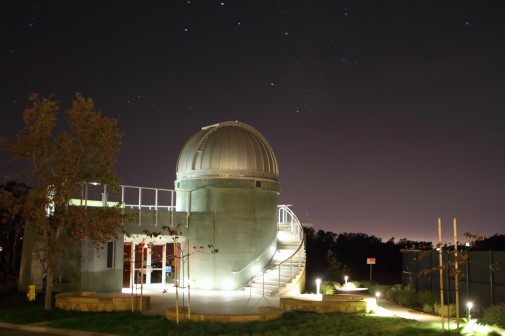Viewing to Feature E.T. Star Cluster
By
Westmont

Stargazers will enjoy seeing globular clusters, planetary nebulae and open clusters on Friday, Sept. 16, during Westmont’s free monthly viewing of the stars. The college’s powerful Keck Telescope, a 24-inch reflector, is housed in the observatory between the soccer and baseball fields. The viewing, held in conjunction with the Santa Barbara Astronomical Unit, begins about 7:30 p.m. and lasts several hours, weather permitting. In case of inclement weather, please call the Telescope Viewing Hotline at (805) 565-6272 and check the Westmont website to see if the viewing has been canceled.
The moon will rise at 9:15 p.m. and will be 85 percent illuminated, drowning out some celestial objects with its glow. But Tom Whittemore, Westmont physics instructor, says we’ll have a chance to see a number of objects before then, including the Owl Cluster, NGC 457. “Surprisingly bright at 9,900 light-years and in the Perseus arm of our galaxy, it looks like an owl with its wings outstretched,” he says. “The owl has two bright eyes, with one that shines with a warm, golden glow. Some people see E.T. in this cluster of 80 to 100 stars, so it’s also known as the E.T. Cluster.”
Two globular clusters will be near the top of the sky, including the Great Globular Cluster, M13, and the often overlooked globular cluster, M92. “It’s illustrative to show these two globular clusters, one after the other, to the public because of the closer concentration of stars in M92 as compared to M13,” Whittemore says. “They each lie about 26,000 light-years away.”
Members of the public may also be able to spy planetary nebulae, such as the Ring Nebula, M57, and the Blinking Planetary, NGC 6826. “The Blinking Nebula is so named because when viewed through a small telescope it appears to blink or disappear as the observer scans the eyepiece,” Whittemore says. “This is because the nebula is faint compared to the inner relatively bright, white dwarf star. When viewed directly the star is easily visible through the cones of the eyes, while the faint, outer nebula is seen with peripheral vision using the more sensitive rods of the eye. I showed this one to a small group of folks at the August viewing, and they really liked it.”
Filed under
Campus Events, Campus News, Press Releases